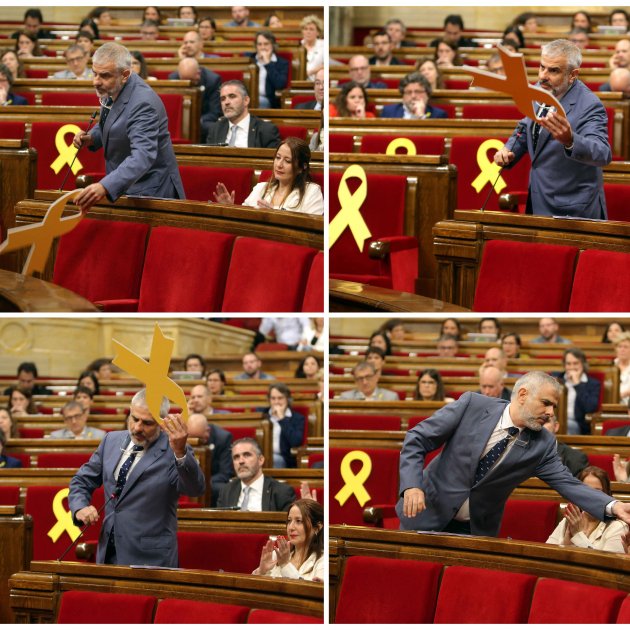Last Friday's session of the Catalan parliament should have been relatively calm. The agenda did not include any appearance by Catalan president Quim Torra with regard to the Spanish government's veto of the nomination of his ministers. All that had to be discussed was the creation of the new Parliament's legislative commissions as well as a committee to investigate the supposed past political espionage of the Catalan government. But the spokesman for the Ciudadanos party (Citizens, or Cs), Carlos Carrizosa, made a scene by removing a symbolic yellow ribbon from the seats reserved for the still-absent government, and this caused the speaker of Parliament, Roger Torrent, to suspend the session.
This spectacle could have remained as just an anecdote if it were not for the context that preceded it. As part of the recent crusade currently being staged by radical groups against Catalan independence symbology, a group of 20 hooded individuals last weekend appeared on the beach of Canet de Mar to remove yellow crosses that had been positioned in support of Catalonia's imprisoned and exiled politicians. When they removed the crosses, five people were hurt, among them a local councillor for the pro-independence CUP party, as well as a woman who was bashed on the head with a cross, and an 82-year old man who received a wound to his neck.
From the beach to Parliament, and from Parliament to the beach. This Sunday a new planting of yellow crosses in the sand was organised, this time on the beach of Mataró. After requests from the Popular Party (PP), the city's municipal council decided to ban the protest, which was intended "to symbolize the death of democracy in the Spanish state". Local police and the Catalan Mossos d'Esquadra force were ordered to deploy to prevent the action. A unionist counter-demonstration was also planned. Although unionist group Segadors del Maresme, the "clean-up brigade" which took responsibility for the violent cross removals in Canet, have distanced themselves from this, a Unionist demonstration was foreseen. In the end, Mataro police inspected the cars of competitors in a triathlon for yellow crosses, pro-independence groups switched from wooden crosses to yellow towels for another action, and there were some isolated incidents with unionists. But an aggressive unionist protest over a yellow ribbon occurred at the door to Barcelona's city hall. And the city hall in the town of Vic was also attacked over the weekend.
Links with the far right
The self-baptised Groups for Defence and Resistance (GDR) were formed as a counter to the Committees for Defence of the Republic (CDR). The GDRs' objective is, they say, “to clean up” public space by removing independence symbology and "to get rid of those who want to create social fracture”. Segadors del Maresme - literally 'Reapers" of the Maresme district, which staged the Canet action, is one of these groups, but there are others like Barcelona's Brigada 155 - the 155 Squad, named after the constitutional article giving the Spanish government direct rule over Catalonia, as well as La Resposta Terrassa (The Response, from the city of Terrassa), Groc Enlloc (Yellow Nowhere) and Democracia y Unidad Española (Spanish Democracy and Unity).
Between these groups and the extreme right there are flirtatious relationships. For example, in a demonstration called by DUE last February in Manresa, Nazi symbology was on display. Another rally also called by DUE included as “guests of honour” Albert Bruguera, Catalonia representative of the neofascist party Democracia Nacional (National Democracy), as well as Josep Alsina and Javier Barraycoa, members of the extremist group Somatemps (We are in time). Alsina was also part of the pro-Nazi party Movimiento Social Republicano (Social Republican Movement, MSR).
The GDRs also include other people linked to the extreme right. Such is the case of Héctor Cocera, member of the Resistència Pont de Vilomara group. Cocera was one of those convicted in 2002 for taking part in the lynching of a Moroccan man at his home in Sant Vicenç de Castellet. The victim Mustapha E. had to be operated on twice and suffered sequelas affecting his head and an arm. Another instance: Jaime Vizern, who posed as a Civil Guard officer in a stunt outside the Waterloo home rented by Carles Puigdemont, is connected to the extremists who were arrested for a racist attack at a centre for minors in Sant Salvador de Guardiola. Vizem is the president of DUE.
The Canet aggression was not the only action of this type which ended in incidents. Less than three weeks ago, the CDR in Vilassar de Mar, also in the coastal Maresme district, denounced an attempted to run over a group of local residents by members of the GDR. This happened at one in the morning, a few hours after the planned action to remove yellow ribbons from Barcelona's Plaça Francesc Macià was dissolved without any action being taken. In the rally prior to that intended action, a hidden camera belonging to the digital media La Directa found that among those present were members of the xenophobic Catalan political party Plataforma per Catalonia (PxC) and the Spanish far-right party VOX.
Photo: Sergi Alcàzar
From the institutions
This rallying cry to remove political content from public spaces has, however, also been made from the highest institutions of the Spanish state. Last Monday, the Spanish government's official representative in Catalonia, Enric Millo, sent a letter to Catalan mayors asking them “to maintain neutrality” in public spaces, including streets and squares, after the incident in Canet. Millo told town councils across Catalonia to comply with “the duty to not allow spaces to be occupied by symbols that could end up damaging social harmony”.
One of those who has followed Millo's instruction to the letter was the Socialist mayor of Lleida, Àngel Ros, who during a council meeting on Friday declared that he had ordered the city's cleaning services to remove yellow ribbons from public spaces. “Offensive graffiti will be erased and symbols not common to all will be removed”, stated Ros.
